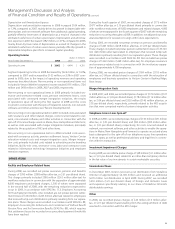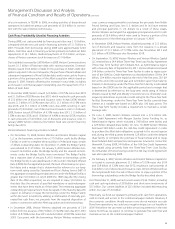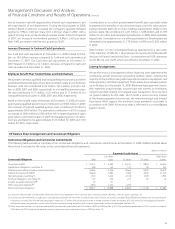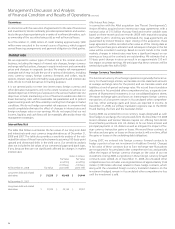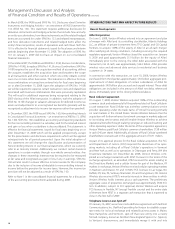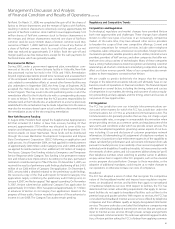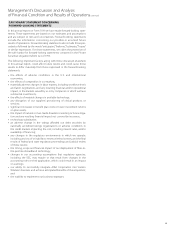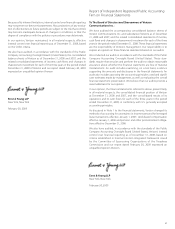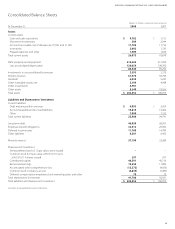Verizon Wireless 2008 Annual Report Download - page 33
Download and view the complete annual report
Please find page 33 of the 2008 Verizon Wireless annual report below. You can navigate through the pages in the report by either clicking on the pages listed below, or by using the keyword search tool below to find specific information within the annual report.
Regulatory and Competitive Trends
Competition and Regulation
Technological, regulatory and market changes have provided Verizon
both new opportunities and challenges. These changes have allowed
Verizon to offer new types of services in an increasingly competitive
market. At the same time, they have allowed other service providers
to broaden the scope of their own competitive offerings. Current and
potential competitors for network services include other telephone
companies, cable companies, wireless service providers, foreign telecom-
munications providers, satellite providers, electric utilities, Internet service
providers, providers of VoIP services, and other companies that offer net-
work services using a variety of technologies. Many of these companies
have a strong market presence, brand recognition and existing customer
relationships, all of which contribute to intensifying competition and may
affect our future revenue growth. Many of our competitors also remain
subject to fewer regulatory constraints than Verizon.
We are unable to predict definitively the impact that the ongoing
changes in the telecommunications industry will ultimately have on our
business, results of operations or financial condition. The financial impact
will depend on several factors, including the timing, extent and success
of competition in our markets, the timing and outcome of various regula-
tory proceedings and any appeals, and the timing, extent and success of
our pursuit of new opportunities.
FCC Regulation
The FCC has jurisdiction over our interstate telecommunications ser-
vices and other matters for which the FCC has jurisdiction under the
Communications Act of 1934, as amended (Communications Act). The
Communications Act generally provides that we may not charge unjust
or unreasonable rates, or engage in unreasonable discrimination when
we are providing services as a common carrier, and regulates some of the
rates, terms and conditions under which we provide certain services. The
FCC also has adopted regulations governing various aspects of our busi-
ness including: (i) use and disclosure of customer proprietary network
information; (ii) telemarketing; (iii) assignment of telephone numbers to
customers; (iv) provision to law enforcement agencies of the capability to
obtain call identifying information and call content information from calls
pursuant to lawful process; (v) accessibility of services and equipment to
individuals with disabilities if readily achievable; (vi) interconnection with
thenetworksofothercarriers;and(vii)customers’abilitytokeep(or“port”)
their telephone numbers when switching to another carrier. In addition,
we pay various fees to support other FCC programs, such as the universal
service program discussed below. Changes to these mandates, or the
adoption of additional mandates, could require us to make changes to
our operations or otherwise increase our costs of compliance.
Broadband
The FCC has adopted a series of orders that recognize the competitive
nature of the broadband market and impose lesser regulatory require-
ments on broadband services and facilities than apply to narrowband
or traditional telephone services. With respect to facilities, the FCC has
determined that certain unbundling requirements that apply to narrow-
band facilities do not apply to broadband facilities such as fiber to the
premise loops and packet switches. With respect to services, the FCC has
concluded that broadband Internet access services offered by telephone
companies and their affiliates qualify as largely deregulated information
services. The same order also concluded that telephone companies may
offer the underlying broadband transmission services that are used as an
input to Internet access services through private carriage arrangements
on negotiated commercial terms. The order was upheld on appeal. In addi-
tion, a Verizon petition asking the FCC to forbear from applying common
31
FairPoint. On March 31, 2008, we completed the spin-off of the shares of
Spinco to Verizon shareowners and the merger of Spinco with FairPoint,
resulting in Verizon shareowners collectively owning approximately 60
percent of FairPoint common stock. FairPoint issued approximately 53.8
million shares of FairPoint common stock to Verizon shareowners in
the merger, and Verizon shareowners received one share of FairPoint
common stock for every 53.0245 shares of Verizon common stock they
owned as of March 7, 2008. FairPoint paid cash in lieu of any fraction of
a share of FairPoint common stock. As a result of the spin-off, our net
debt was reduced by approximately $1.4 billion. Both the spin-off and
merger qualify as tax-free transactions, except for the cash payments for
fractional shares which are generally taxable.
Environmental Matters
During 2003, under a government-approved plan, remediation com-
menced at the site of a former Sylvania facility in Hicksville, New York
thatprocessednuclearfuelrodsinthe1950sand1960s.Remediation
beyond original expectations proved to be necessary and a reassessment
of the anticipated remediation costs was conducted. A reassessment of
costs related to remediation efforts at several other former facilities was
also undertaken. In September 2005, the Army Corps of Engineers (ACE)
acceptedthe HicksvillesiteintotheFormerlyUtilizedSitesRemedial
Action Program. This may result in the ACE performing some or all of the
remediation effort for the Hicksville site with a corresponding decrease
in costs to Verizon. To the extent that the ACE assumes responsibility for
remedial work at the Hicksville site, an adjustment to a reserve previously
established for the remediation may be made. Adjustments to the reserve
may also be necessary based upon actual conditions discovered during
the remediation at any of the sites requiring remediation.
New York Recovery Funding
In August 2002, President Bush signed the Supplemental Appropriations
bill that included $5.5 billion in New York recovery funding. Of that
amount, approximately $750 million was allocated to cover utility res-
toration and infrastructure rebuilding as a result of the September 11th
terrorist attacks on lower Manhattan. These funds will be distributed
through the Lower Manhattan Development Corporation and Empire
State Development Corporation (ESDC) following an application and
audit process. As of September 2004, we had applied for reimbursement
of approximately $266 million under Category One and in 2004 and 2005
we applied for reimbursement of an additional $139 million of Category
Two losses. Category One funding relates to Emergency and Temporary
ServiceResponsewhileCategoryTwofundingisforpermanentrestora-
tion and infrastructure improvement. According to the plan, permanent
restoration is reimbursed up to 75% of the loss. On November 3, 2005, we
received the results of preliminary audit findings disallowing all but $49.9
million of our $266 million of Category One application. On December 8,
2005, we provided a detailed rebuttal to the preliminary audit findings.
We received a copy of the final audit report for Verizon’s Category One
applications largely confirming the preliminary audit findings and, on
January 4, 2007, we filed an appeal. That appeal is pending. On November
9, 2007, Verizon submitted an additional Category Two application for
approximately $16 million. ESDC has approved approximately $17 million
in advances to Verizon on its Category Two applications. Based on the
progress of these audits, Verizon recorded a portion of these advances to
income in June 2008. The Category Two audits remain pending.
Management’s Discussion and Analysis
ofFinancialConditionandResultsofOperations continued




